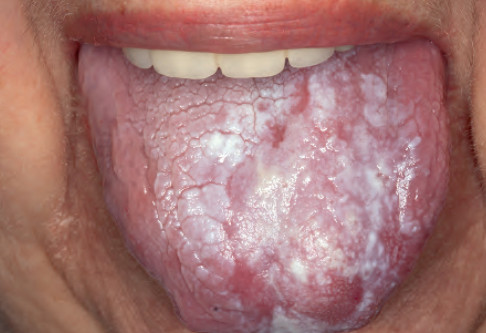Oral lichen treatment
Types of oral lichen
- Reticular ( most common type).
- Atrophic.
- Bullous.
- Erosive.
- Papular.
- Pigmented.
- Plaquelike.
Exclude the following conditions
Differential diagnosis of oral lichen
- Drug induced “lichenoid” reactions
- Discoid / Systemic lupus erythematosus
- Non specific ulceration
- Candidosis
- Leukoplakia
- Hairy Leukoplakia
- Mucous Membrane Pemphigoid
- Pemphigus vulgaris
- White sponge naevus and other genodermatoses
- Cheek biting.
Tips

- Oral mucosal lesions (OLP) occur in 50–70 % of the patients with LP.
- Regular clinical follow up is advised because patients with oral lichen planus (OLP) are at increased risk for cancer, especially squamous cell carcinoma (SCC).
- Oral lichen planus occurs without cutaneous disease in 23% of LP patients and commonly follows a chronic course.
- It is more common in females than males.
- Patients with oral LP should be questioned about symptoms related to esophageal involvement and examined for other mucosal lesions, particularly genital lesions, and vice versa, because ~70% of patients with mucosal vulvovaginal LP have clinical signs of oral LP.
- Good oral hygiene and dental care are recommended.
- Patient should be advised to avoid spicy foods, tobacco, alcohol and acidic drinks.
- Candida infection was found in 17% to 25% of ulcerated and nonulcerated cases, consider antifungals.
- If the patient is hepatitis C virus positive, immunosuppressive treatments should be avoided to prevent hepatocarcinoma to develop.
- The treatment is mainly asymptomatic, asymptomatic lesions may not be treated.
- Local anesthetics may be used to reduce the pain : lidocaine 2% gel
Medical treatment options
First line
- Mild to moderate cases
- Topical corticosteroids:
- Clobetasol propionate 0.05% ointment three times daily with a gloved finger on erosive lesions.
- Orabase formulation may be used.
- Avoid drinking or eating for an hour after the application.
- Clobetasol propionate 0.05% ointment three times daily with a gloved finger on erosive lesions.
- Fluticasone propionate spray (50mcg per puff), directed to affected areas up to 3-4 times daily.
- Beclometasone spray (100mcg per puff), sprayed 3-4 times daily on affected sites.
- Betamethasone propionate 0.05% gel or ointment
- Dexamethasone: 5 mL [0.5 mg/5 mL] used as a mouth wash up to six times daily.
- Prednisolone tablet 5 mg dissolved in 15 mL water used as a mouthwash swish three times daily.
- Topical corticosteroids:
- For severe cases
- Oral corticosteroids: Prednisolone: 0.5-1 mg/kg/day until remission then slow tapering the dose.
Second line
- Topical retinoids alone or used with topical corticosteroids (For plaque type)
- Retinoic 0.05% acid.
- Isotretinoin 0.1 % gel.
- Oral corticosteroids : (For erosive lichen with no improvement on topical treatment)
- 1 mg/kg/day until remission ( about 4-6 weeks).
- Intralesional corticosteroids:
- Triamcinolone acetonide: 0.5 mL of ( 40 mg/mL).
- Triamcinolone acetonide: 8 mg weekly for 2 wks.
- Betamethasone: 1.4 mg weekly for 2 wks.
- Methylprednisolone acetate (Depo-Medrol 40 mg/mL): 0.5 to 1.0 mL.
Third line
- Topical calcineurin inhibitors
- Tacrolimus 0.1% oint: (4 times daily)
- use for a limited duration(potential risk of cancer)
- Burning sensation is the commonest side effect.
- Pimecrolimus (Elidel cream):2 times daily.
- Cyclosporin:5 mL of a 100 mg/mL solution as mouthwash twice daily.
- Tacrolimus 0.1% oint: (4 times daily)
- Aloe Vera Gel and Juice.
- Dapsone : 50 to 150 mg/day.
- Screening for G6PD deficiency is required.
- Hydroxychloroquine sulfate (Plaquenil): 200 to 400 mg daily, is useful for oral LP. Erosions require 3 to 6 months of treatment before they resolve.
- Mycophenolate mofetil : 1000 -2000 mg/day, effective in a case of oral erosive lichen planus.
- Azathioprine: 50–100 mg/day) may be used in erosive OLP with chronic active hepatitis.
- Methotrexate: 2.5 to 15 mg a week.
- Curcuminoids : 6000 mg/day in three divided doses.
Physical treatment options
- Cryotherapy.
- Puva
- Excimer laser.
- Carbon dioxide laser.
- Photodynamic therapy
References
- http://www.exodontia.info
- Griffiths, C., Barker, J., Bleiker, T. O., Chalmers, R., & Creamer, D. (Eds.). (2016). Rook’s textbook of dermatology. John Wiley & Sons.
- Dermatology , Edited by Jean L. Bolognia , Julie V. Schaffer , Lorenzo Cerroni Fourth edition: Elsevier, 2018, ISBN 978–0‐7020–6275–9
- Braz. J. Pharm. Sci. vol.56 São Paulo 2020 Epub Apr 06, 2020.